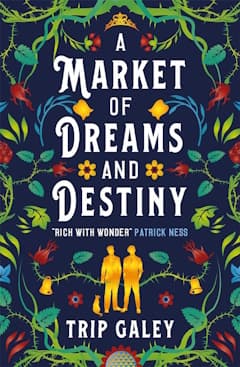
A Market of Dreams and Destiny by Trip Galey
(Titan Books, 2023)
Reviewed by Steven French
These days Covent Garden is a well-known tourist destination, famous for its craft market, buskers, bars and restaurants. A hundred and fifty years ago it had a much seedier reputation, subsequently leavened somewhat in the popular imagination by Shaw’s flower-seller, Eliza Doolittle. And it is around this time that Galey’s rich and engaging fantasy novel is set, albeit in a very different London than that of Shaw or Dickens. This is the metropolis that was shaped by a treaty signed between two powerful queens: Elizabeth I and Tatiana, the Faery monarch. And so, underneath Covent Garden Market lies another, the ‘Untermarkt’, where dreams and desires, power and abilities are for sale, all for the right price of course, where that may not be measured in pounds, shillings or pence. Ducking and diving through this goblin market on a daily basis is Deri (Welsh for ‘oak’), the indentured servant of Maurlocke, a renowned and powerful merchant whose grip on Deri’s activities is firm, occasionally brutal but not so tight that the lad can’t find ways to make a little for himself on the side, with the aim of buying out of his contract in a year or two. That aim suddenly appears much, much closer when Deri is faced with an opportunity he really can’t turn down: the chance to acquire the destiny of a Crown Princess.
Such a thing is of immense value of course and Deri has to secret it away, beyond the purview of not only Maurlocke but also Aurelia, a Knight of the Verge, tasked with finding the missing princess. However, his plan to sell on the destiny and make a name, and place, for himself within the market are complicated by a chance encounter with Owain, also indentured but to the appropriately named Missus Graspar and her son Garog, workhouse owners and all-round nasty pieces of work. Threading through all of Deri’s machinations from that moment on are his burgeoning feelings for Owain together with his fears, as the factory where Owain risks life and limb is upgraded with powerful machinery devised by Aurelia’s sister Silverstra. Although she has inherited their father’s inventiveness, she remains woefully unaware of the power-source the Graspars have chosen for her novel mechanisms. Deri needs more than just physical and mental agility to ensure the interlocking gears of his complicated plan to save Owain and the other workhouse children, and buy a future for himself, all mesh together smoothly and a great part of the joy in this book is seeing how he makes best use of whatever luck comes his way and overcomes assorted obstacles, some expected, others very much not so.
And there is joy here, because off-setting the poverty and grime and outright brutality, there is the romance between Deri and Owain which is both heart-wrenching and heartening, as one reveals the other-worldly details of his past and the other finds himself presented with a very different future. This is also a book about the grinding effects of raw capitalism, mitigated by the power inherent in workers organising themselves, with the latter exemplified by Owain’s friend and workmate, Vimukti, who gives up her healing abilities to become, essentially, a union organiser. All these moving parts are handled with humour and a lightness of touch that also pops up in the names of a few of the Untermarkt’s customers, such as a certain Mr Copperfield, a Miss Haversham and—lols all round—Fey Ghin.
Well-written and perfectly paced with just the right balance between action and reflection, this is an outstanding addition to the ‘city under the city’ sub-class of urban fantasy; indeed, in its cleverness and the scale of its invention, I think it can be happily and justifiably placed alongside Gaiman’s Neverwhere.
Review from BSFA Review 22 - Download your copy here.
